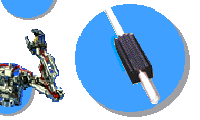


|
2004: Lo sbarco su Marte (articolo di Richard Stenger tratto dalla CNN del 5 gennaio 2004) NASA rover finds Earth in Martian sky
PASADENA, California - On its first full day on Mars, a robotic explorer locked in on Earth with its most powerful antenna on Monday, a crucial technical accomplishment that allows it to beam images and data directly home without interruption. The $400 million NASA craft Spirit, after landing over the weekend, had used the smallest of three antennae to relay brief messages via Martian satellites, but they can only be reached a few minutes a day as they streak over the landing site, a giant crater thought to have been flooded with water eons ago. Now the six-wheeled rover, designed to conduct unprecedented geologic and photographic surveys of the Martian surface, can hail Earth without a middleman for hours at a stretch with its lollipop-like, high-gain antenna. "A disadvantage to sending [information] via an orbiter is that the orbiter stores it and sends it later. There's a much greater time lag before you get information back," said Matt Golombek, a NASA scientist at the Jet Propulsion Laboratory in Pasadena, California. "It gets you the critical information you need at the end of one Martian day and use it to plan the next day," the planetary researcher said. Martian daze Golombek and others on the rover team have adopted a Mars schedule, coordinating their waking and sleeping patterns with Martian days, which are nearly 40 minutes longer than those on Earth. They have blacked out their windows to prevent sunlight from coming in. Some even sport watches that measure Mars time. "My cats are staying with my husband, so they get to stay on Earth time," quipped mission scientist Wendy Calvin. The rover, also trying to become accustomed to a strange new world, will need at least a week before it begins roaming around Gusev Crater, a nearly 100-milewide pockmark just south of the Martian equator. The golf cart-sized machine needs a chance to stretch, stand up and test its tools and wheels before NASA cuts its umbilical cord, a thick line that secures it to the landing platform, and turns it loose for its planned 180-day jaunt. Cutting the cord "We have to cut that last cable. That's when the rover is really born," said Mark Adler, manager of the Spirit mission. In the meantime, mission engineers are poring over data to check Spirit's operational health. By all accounts, the robot ship made a nearly flawless landing late Saturday, far surpassing even the most optimistic predictions of precision to hit its landing target. Within hours of touchdown, Spirit beamed back black and white images from its new home, including a stunning panorama complete with a nearly setting sun and a possible cliff face along a depression or mini-crater inside the crater. It may prove an irresistible draw for its Earth-bound drivers, should more data determine that it is within roaming range. But they maintain they will exercise restraint when selecting points of interest to visit, no matter how tantalizing. Beware of rover trap Steven Squyres, a Cornell University geologist in charge of the robot's instruments, speculated that the hollow contains fine-grained soil that could bog down Spirit's wheels. "I'm not sure that's not a rover trap," said Squyres, who will also manage the scientific payload on Spirit's identical twin, Opportunity, which will complete the 300-million-mile trip to Mars in late January, landing on the opposite side of the planet. For the most part, the science team was ecstatic about the quality of the landing spot. There are plenty of rocks for interesting geologic fieldwork, but few or no boulders to block its path. And save for the "rover trap," most of the area appears swept clean of possibly troublesome dust. One of Spirit's first images, a partial self-portrait, shows the Martian surface in Gusev crater. Spirit and Opportunity have considerably more mobility and capability than the most recent successful visitor to Mars. The 1997 NASA mission included the Pathfinder lander, which beamed back thousands of images, and Sojourner, a toy-sized test rover that scurried around the rocks and boulders littering the landing site. Each of the new rover, however, is built to explore nearly as much territory in several days as Sojourner covered in three months, about 100 yards. And each comes equipped with eight cameras that should provide stunning panoramas of the Martian surface, with resolutions so sharp they retain crisp detail when blown up to the size of a movie screen, according to NASA. Their microscopes, spectrometers and drills could unlock geologic secrets from billions of years ago, when scientists think the cold and dry planet may have been warm and wet enough to host life. |
